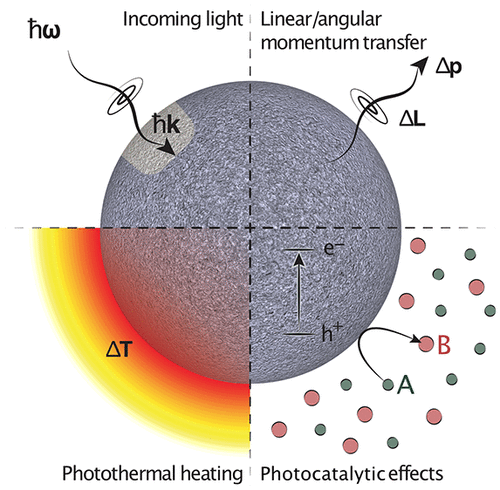当前位置:
X-MOL 学术
›
Chem. Rev.
›
论文详情
Our official English website, www.x-mol.net, welcomes your
feedback! (Note: you will need to create a separate account there.)
Nanoscale Inorganic Motors Driven by Light: Principles, Realizations, and Opportunities.
Chemical Reviews ( IF 51.4 ) Pub Date : 2019-12-23 , DOI: 10.1021/acs.chemrev.9b00401 Hana Šípová-Jungová 1 , Daniel Andrén 1 , Steven Jones 1 , Mikael Käll 1
Chemical Reviews ( IF 51.4 ) Pub Date : 2019-12-23 , DOI: 10.1021/acs.chemrev.9b00401 Hana Šípová-Jungová 1 , Daniel Andrén 1 , Steven Jones 1 , Mikael Käll 1
Affiliation

|
The prospect of self-propelled artificial machines small enough to navigate within biological matter has fascinated and inspired researchers and the public alike since the dawn of nanotechnology. Despite many obstacles toward the realization of such devices, impressive progress on the development of its basic building block, the nanomotor, has been made over the past decade. Here, we review this emerging area with a focus on inorganic nanomotors driven or activated by light. We outline the distinct challenges and opportunities that differentiate nanomotors from micromotors based on a discussion of how stochastic forces influence the active motion of small particles. We introduce the relevant light-matter interactions and discuss how these can be utilized to classify nanomotors into three broad classes: nanomotors driven by optical momentum transfer, photothermal heating, and photocatalysis, respectively. On the basis of this classification, we then summarize and discuss the diverse body of nanomotor literature. We finally give a brief outlook on future challenges and possibilities in this rapidly evolving research area.
中文翻译:

光驱动的纳米无机电机:原理,实现和机会。
自纳米技术问世以来,足够小以在生物物质中导航的自推进式人工机器的前景已引起研究人员和公众的兴趣,并激发了他们的灵感。尽管在实现此类设备方面有许多障碍,但在过去的十年中,其基本构件纳米电机的开发取得了令人瞩目的进展。在这里,我们将重点研究由光驱动或激活的无机纳米电动机这一新兴领域。在讨论随机力如何影响小颗粒的主动运动的基础上,我们概述了将纳米电机与微电机区分开的独特挑战和机遇。我们将介绍相关的光物质相互作用,并讨论如何利用它们将纳米马达分为三大类:分别由光动量传递,光热加热和光催化驱动的纳米马达。在此分类的基础上,我们然后总结和讨论了纳米电机文献的各个方面。最后,我们对这个快速发展的研究领域中的未来挑战和可能性作了简短的展望。
更新日期:2019-12-23
中文翻译:

光驱动的纳米无机电机:原理,实现和机会。
自纳米技术问世以来,足够小以在生物物质中导航的自推进式人工机器的前景已引起研究人员和公众的兴趣,并激发了他们的灵感。尽管在实现此类设备方面有许多障碍,但在过去的十年中,其基本构件纳米电机的开发取得了令人瞩目的进展。在这里,我们将重点研究由光驱动或激活的无机纳米电动机这一新兴领域。在讨论随机力如何影响小颗粒的主动运动的基础上,我们概述了将纳米电机与微电机区分开的独特挑战和机遇。我们将介绍相关的光物质相互作用,并讨论如何利用它们将纳米马达分为三大类:分别由光动量传递,光热加热和光催化驱动的纳米马达。在此分类的基础上,我们然后总结和讨论了纳米电机文献的各个方面。最后,我们对这个快速发展的研究领域中的未来挑战和可能性作了简短的展望。











































 京公网安备 11010802027423号
京公网安备 11010802027423号